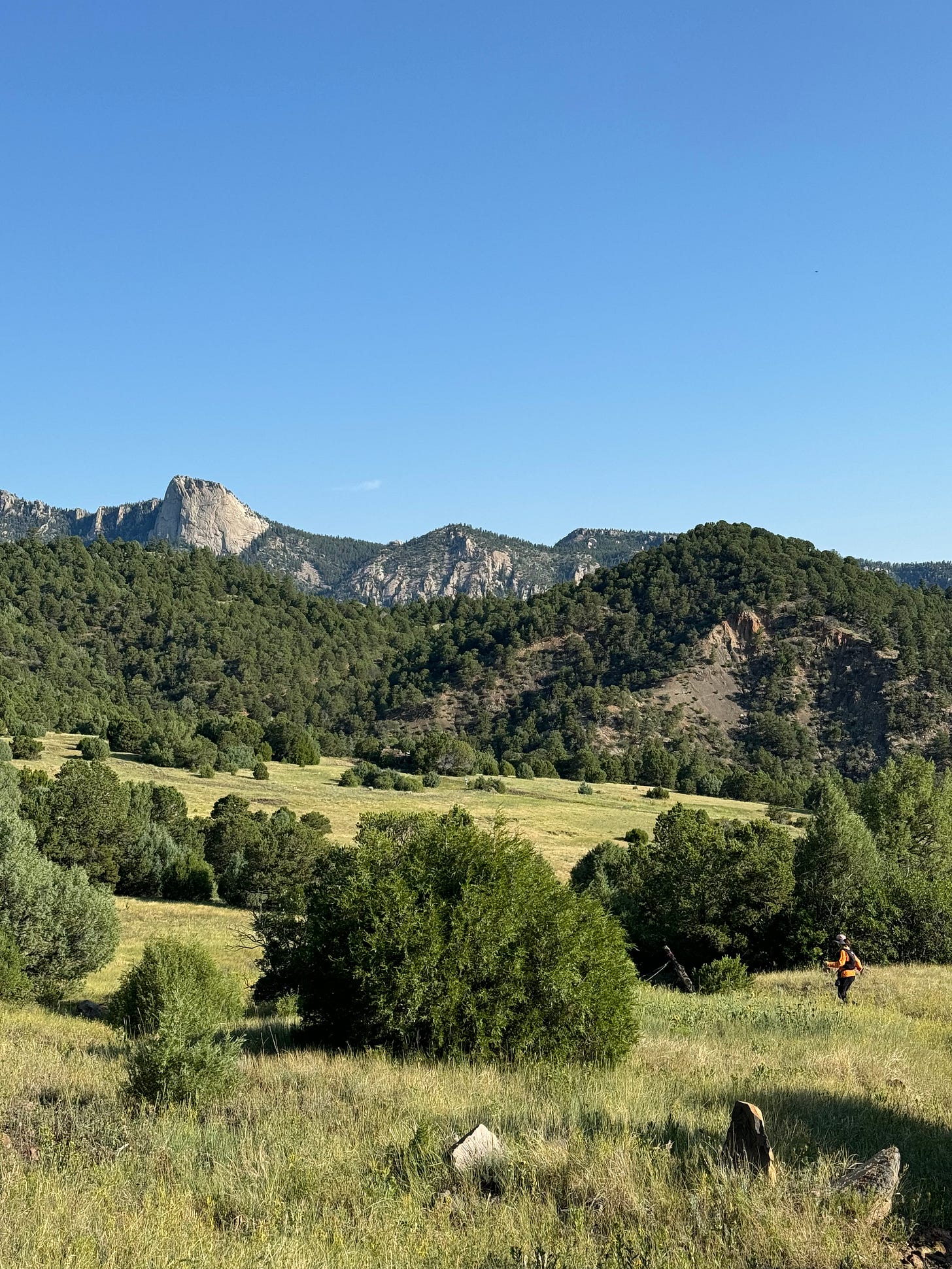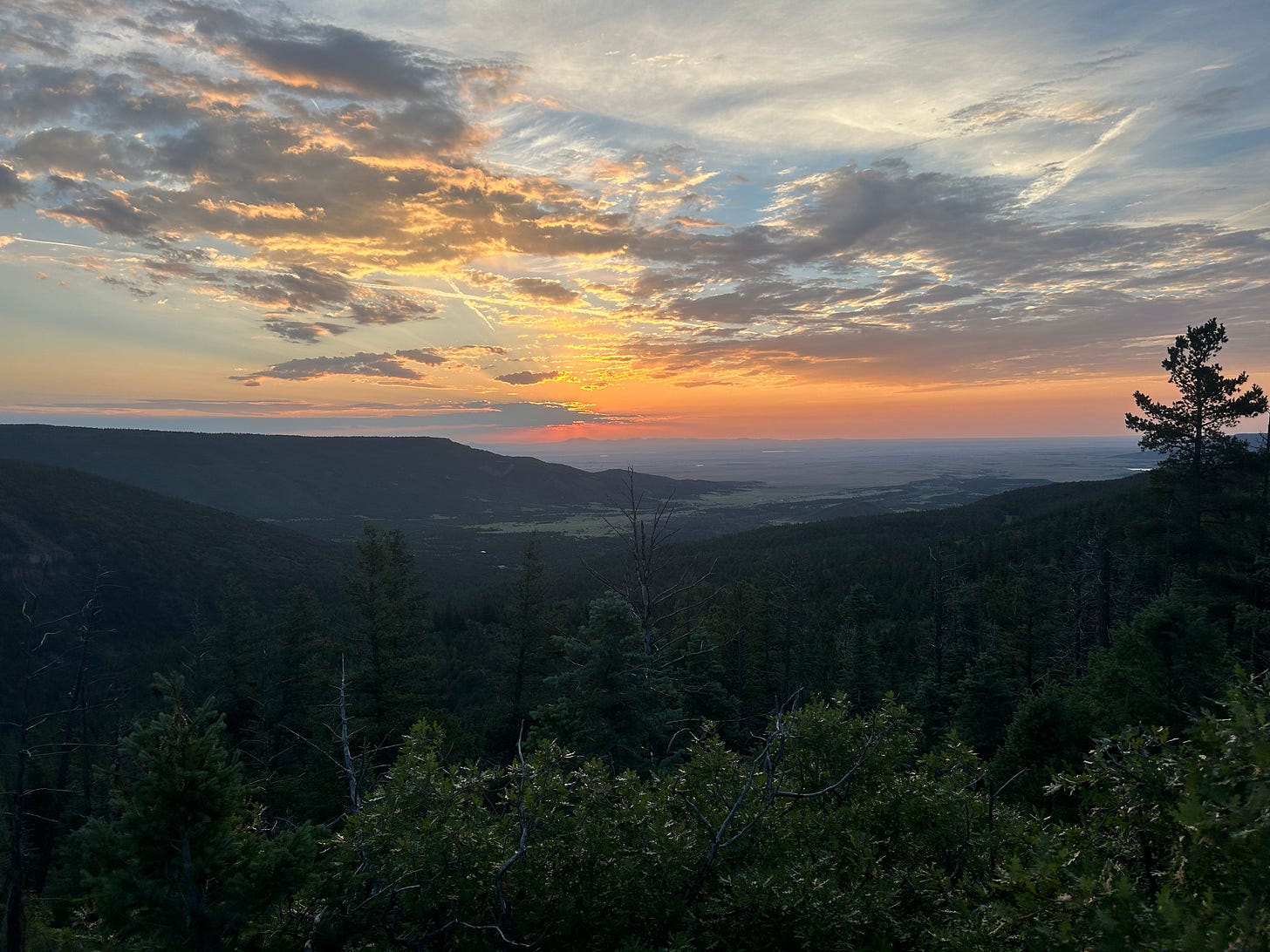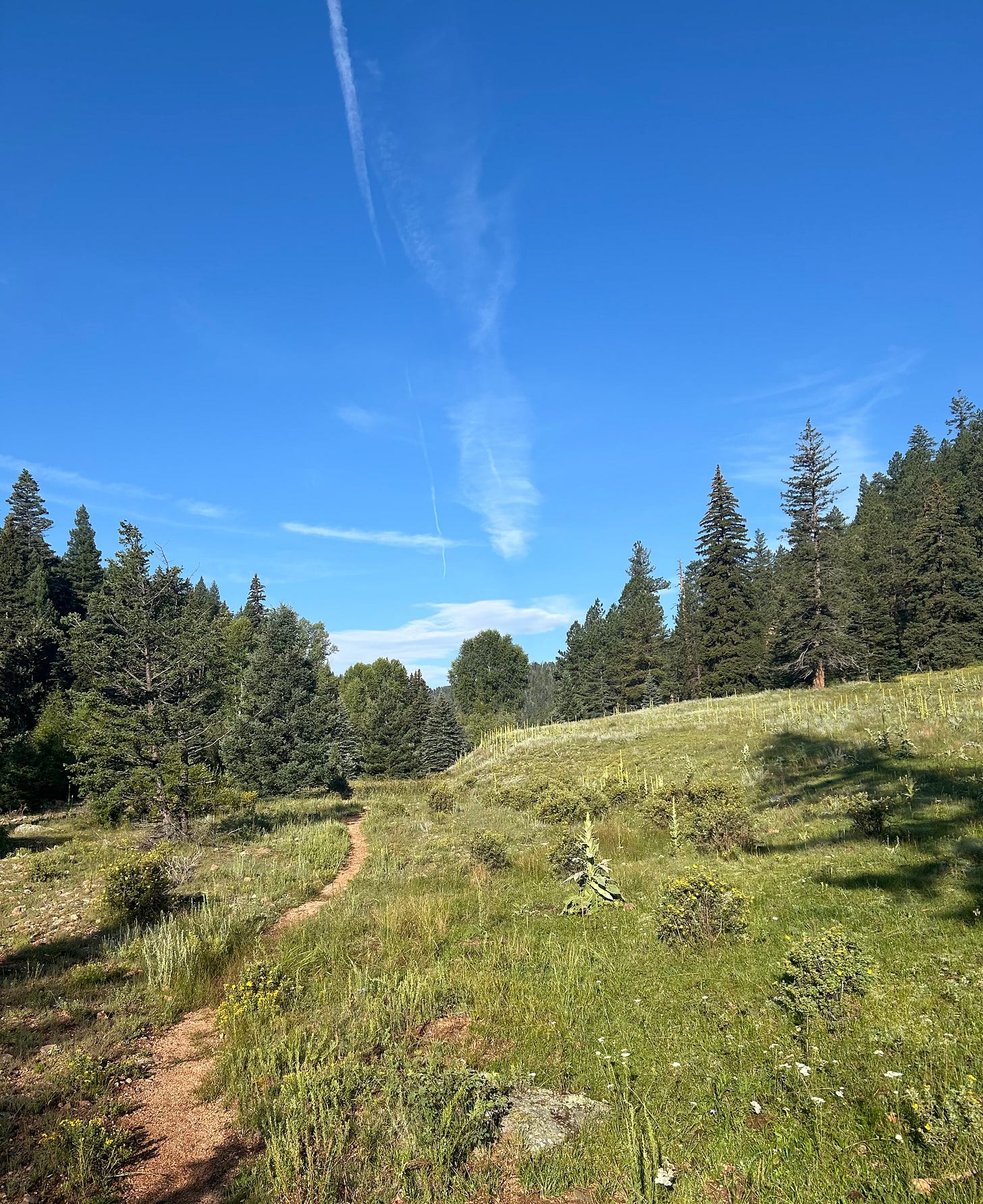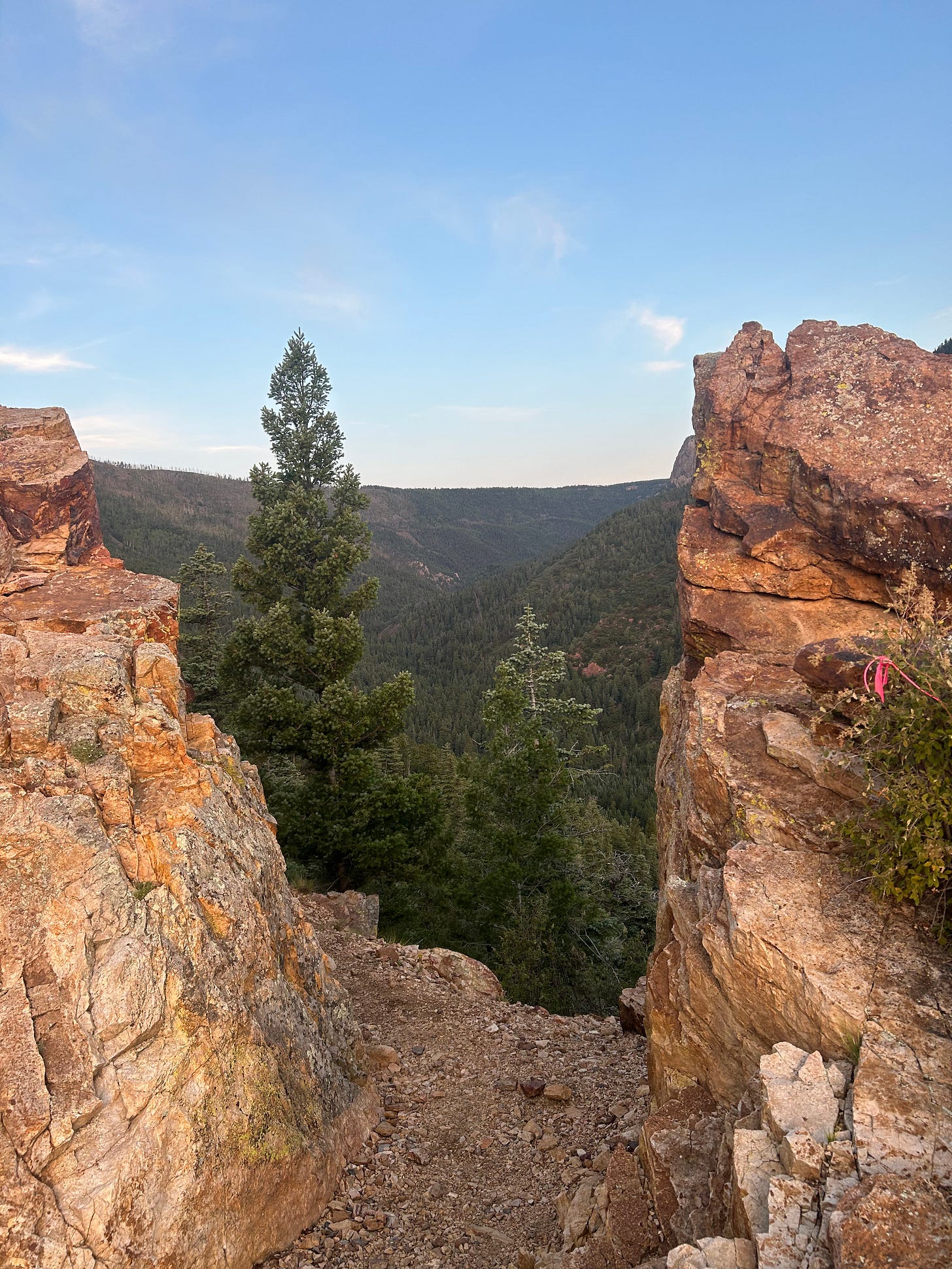Out of the darkness erupted obnoxious yelling from the rangers at the front of the bus. Being two hours before sunrise, the shouting was a shock to the system. Crammed into a seat made for adolescents, adjacent the rear emergency exit, I looked up just in time to hear most of the rest of the occupants join in with the chanting. Everyone on the bus was dressed like me, in our full ultramarathon kits, but I started to suspect I was an outsider. The yelling and echoes continued as the bus hurtled down the road into the early morning. With each bump in the road, my 270-pound body rose in the air while my stomach was stationary. Due to the overwhelming darkness, I was unable to anticipate the lurches as the bus appeared to leave the road every few seconds and my stomach began to turn. Just before the bus started to slow, I began to wonder if we were going to make it to the starting line of the Philmont Trail Race – 50 Mile race.
The race is held at the Philmont Scout Ranch in Cimarron, New Mexico during the first weekend of August. The ranch, which is owned and operated by the Boy Scouts of America, situated in the Sangre de Cristo Mountains, is home to 140,000 acres of pristine wilderness. The high plains of eastern New Mexico end where the ranch begins, with the mountains seemingly rising out of nothing as you approach it from the east.
My pal Jared asked Barry (my other pal) and I for adventure in New Mexico. With Barry being somewhat local and I having grown up in New Mexico and Texas, we figured it would be a good place to meet. I hit up the Ultra Running Magazine website and entered my criteria into the search. There are surprisingly few ultras in New Mexico, but one race fit the bill. It had an 8-mile, 18-mile, marathon, and 50-miler all within a two-hour drive of my parents’ cabin. Philmont, here we come.
Barry and I were immediately in. Jared, whose idea it was (and who also does not subscribe to this Substack, even though he said he would, so I can say whatever I want about him) seemed intimidated by the idea of a high-country adventure and declined to participate despite repeated harassment from his buddies. I settled on the 50-mile option since I had no experience with the distance and I figured that my maiden voyage should be through the mountains and at altitude. This was especially important to me since I live and train below 500 feet.
A couple of months removed from Ridge to Rails, the race had finally arrived. I made my way out west and up into Santa Fe National Forest for a few days. Barry met me and we managed to get a few miles in (off trail, of course) and spend a little time in Santa Fe. On Friday, we packed up and headed north for Cimarron. We did a little sightseeing in Las Vegas (the New Mexico edition) and Wagon Mound, where a branch of my family has been for hundreds of years.
The rain seemed to be focused on the compound directly east of us. From the road, Barry in the driver seat and me in the passenger seat, we could see for miles across the prairie that ended where the mountains began. At the base of the mountains, we would see what we assumed was Philmont Scout Ranch and our destination. The rain hammered the ranch and nothing else. The surrounding areas may as well have had their own weather forecast. As we got closer and closer to the ranch, it seemed like the rain was never going to relent. Our drive came to an end as we pulled in and we were immediately struck with the spirit of the ranch. There were numerous buildings, tents, and deer with the biggest racks I had ever seen (you know what I mean), with the Tooth of Time watching over us. It was easy to get lost in a place so big and that’s exactly what happened.
We finally found our way to packet pick up where we got our bibs, and I got my drop bags. We were also assigned our canvas tent that we would be sharing for the night. The race was kind enough to provide accommodations for the participates since there were limited options in neighboring Cimarron. The tents went on for miles it seemed, row after row. The tents were typically used by inbound and outbound backpackers as a base of operations before starting or after finishing their adventure. The racers were grouped by distance, except Barry who had requested to stay with me, so he did not end up sharing with some weirdo.
We moved our provisions to the tent, which was quite a feat, seeing how this camp is designed for people carrying everything on their backs and there was no way for us to drive up to the tent. We began preparing for the next day and chitchatting with our fellow racers. A common theme amongst the racers we met were that they had all been here before as scouts and this was their only opportunity to experience the trails again. We learned that they almost spoke their own language. Barry and I soon realized we had stumbled into a cult of sorts.
I was relieved as the bus came to a stop, surprised we made it safely. Now fully aware I was an interloper that had infiltrated the cabal. I had my suspicions the night before but that was confirmed with the chanting on the bus ride to the start. As an ultrarunner, I thought I was in an exclusive club, but now I was watching a group of people that had bonded over this piece of land come alive. They may not have known each other before this race, but most of them were connected through this fellowship that was Philmont. It was fun to watch.
Everyone stood and slowly filed off the bus and in an orderly fashion. I had been hydrating in anticipation of a hot, alpine day and needed to relieve myself pretty bad after that bus ride from Hell. It felt weird pissing on this seemingly holy ground. I shook it off and made it to the back of the pack just in time for the horn to go off, signaling the start of the longest distance I had ever attempted.
We all filed up a gentle climb up a dirt road to the first camp, about two miles from the start, which had our first and most pointless aid station. It was so unnecessary that they were not even set up when we got there a little after 5 a.m. From there, we started some more aggressive climbing up to the top of the canyon on single track. At this point, I was solidly in last place but moving well. I had 18 hours to complete this race so moving forward was the only plan I had. We continued the traverse along the side of the canyon for about eight miles. This was more or less flat, but I could tell my legs were starting to fatigue a bit.
I kept pressing forward. I had enough electrolyte drink at the start of the race to cover me for 10 miles because the first aid station was only two miles in and the second was 10 miles in. Unfortunately, I was not wanting to drink any of it. I later learned that this is common at altitude. I finally arrived at Fish Camp, the second aid station after climbing about 2,000 feet since the start. I did not even need to fill my bottles because I had not consumed hardly any of it on the way there. I lubed up my nether regions before pressing forward. I was sweating a lot more than I had expected to and was not drying off as quickly as I had anticipated, which was causing some additional chaffing.
After leaving the aid station, I entered a 4-mile section through a picturesque mountain valley, complete with a stream and wildflowers. While beautiful, I had not felt this isolated in quite a long time. This section was a gentle climb that I thought I was going to make up some time on, but things began to take a turn for the worst. My legs started to get really stiff and my leg muscles felt powerless. I had put in the work for this race. I ran in the mountains and heat every chance I got. I was prepared. I knew every inch of the route. But suddenly it seemed, I could barely move.
Once the legs went, so did the mind and I could not get it back. I trudged forward through the valley until I hit some switchbacks that would take me up to the next aid station. My pace continued to fall off a cliff and I had no answers as to why in the moment. I was not even a third of the way into the race and I had no energy, how could I keep going for 37 more miles? I finally reached the 13-mile aid station and noticed it was manned with 20-year-old Philmont Rangers. I gave my pain a voice and told them that I was not feeling great, but they encouraged me to keep moving because the next section was relatively flat. I refilled my bottles, still not finished with the electrolyte drink in my bladder that I started with.
The section was flat…ish but I was falling apart both mentally and physically. It was the highest point of the course so far and the altitude was really taking its toll on me. The only upside was that as I neared 10,000 feet of elevation, I was able to see some peaks off in the distance. It was during this section I resolved to call it a day. I was not feeling good. I could not drink enough. My legs were shells of their former selves. I also started doing some “ultra math” and figured at this pace, I would get cut off at the next aid station if I continued at my current pace. And even if I did make it through the next aid station, I would be caught in a thunderstorm while at the top of Mt. Phillips. All these reasons made perfect sense to me to go ahead and quit once I reached the aid station at 17 miles1. As I approached, I saw a Suburban and my ticket out of there and to a nice meal once I got back.
We bumped along the gravel road cut into the side of the mountain. The ruts caused me to damn near fly out of my seat as we moved through them at 10 miles per hour. Through the trees to the right, you could see the ridge line across the canyon, and you could not help but look down and wish there was a little more shoulder between the SUV and the sheer drop to the bottom. The white Philmont Suburban was piloted by a kid that could not have been more than 22. I sat in the middle row hoping to keep what little I had in my stomach down, while also enjoying the view that none of my competitors had.
When I told the aid station worker I was going to drop, they told me they had to stay until it closed and then we would pack up, drive 45 minutes to the next aid station to extract those volunteers and then it would be a two-hour drive back to base. It was then that I began to comprehend just how isolated we were out there. The next aid station was about six trail miles from where I dropped. It marked the start of the final push up to the top of Mt. Phillips. When we arrived, most of the runners had already come through, but we were still waiting on a few.
The sky had grown dark, and the rain clouds had moved in. I could not help but wonder how scary it was at the summit of the 11,742-foot peak with the thunderstorm starting to unleash its fury. We hung around the camp waiting for the official cutoff so we could begin the drive back to base. I got to watch as the scouts that were camping raced to set up their shelters before the rain started. One runner that had been at the aid station where I dropped when I came in left this aid station and within a few minutes was back having decided that he was not going to be on that summit during the storm. We only had one more runner to account for. We waited. And waited. The race staff did not have any record of him coming through the aid station. After the cutoff, the staff got on the radio with base and discovered no one had any record of him arriving at a later aid station.
Within minutes, two young adult males dressed in historical costumes were changed into hiking clothes. They donned packs and radios, and they were off to backtrack to the last known location of the runner. Over what seemed like hours, we waited for any word on the missing runner. We could not return to base until the runner was found in case we needed to evacuate the runner. I counted up the seats in the vehicle and knew someone would get booted if we took on anyone else. While we waited, I got to know some of the volunteers that would be riding back with us. They confirmed many of my suspicions about this being an outdoor sect.
I heard words like “Phil-marriage,” or a marriage between two rangers that had met when they worked at the ranch. Most of the volunteers were former rangers and this was the only way for them to get back out onto the ranch. Most did not have any connection to running or ultrarunning. They just wanted to be near the ranch again, if only for a few hours. They all reminisced and gossiped about the ranch and the leadership and the Boy Scouts of America. None of these people were here at the same time when they were rangers but they were all deeply connected to the land we stood on and that in turn connected them to their fellow, former rangers. I was just there because it looked like a fun race through a property I always heard about, and the logistics were easy enough with my family cabin nearby. I almost felt bad about being there. $200 and a little bit of fitness granted me access to one of the most stunning tracts of land I had ever seen.
We finally got word that the runner came through the aid station hours ago and the volunteers and staff had missed him. I thought this was weird that a bunch of 18 to 22-year-olds, dressed in costumes and put in charge of handing out quesadillas in the middle of the woods had missed a runner, but I guess anything is possible. My legs had stiffened at this point and I was hobbling around but regretting my decision to drop. Had I known it would have taken six hours to exfil, I probably would have just kept moving and taken my chances with the lightning. But I couldn’t reverse that decision now.
We all piled into the Suburban. All eight of us. We started retracing our steps back to the aid station where I quit. My thoughts went to Barry, wondering how long he had been finished with his marathon and if he was enjoying some pizza. The ride would take the better part of two hours, and I just had to sit there and make the most of it. Fortunately, that was not hard. We drove through the heart of the ranch. The scenery was so breathtaking that I was actually glad I quit when I did. I got to go on a vehicle tour of the ranch that no one else was privy to. Had I been cut off later, we would have been making a similar drive, but in the dark. I did not mind that I had nothing to add to the conversation because all I had to do was look out the window and I was instantly taken back 100 years.
We finally popped out of the valley and I could see the Tooth of Time towering over the Philmont base camp. It was still a 30-minute drive but now the views of the mountains were wide open. I knew the runners would be running past the Tooth of Time before descending back to camp and the finish line and I wondered what that would have felt like. I received word that the race director wanted to see the two dropped runners when we got back. Once out of the car, my soreness and my chaffing where made very apparent and I was pissed that I now had to walk across the entire complex so the RD could look at my sorry self. In the end, it worked out because Barry was only a few minutes from crossing the finish line and I was able to video him. He had a similarly rough day but was able to push through and get his medal (Weather Permitting Podcast Recap).
We quickly threw our stuff in his truck. “Quickly” was relative at this point. We had a 500-yard walk and neither of us were in any condition to be carrying all our stuff over this distance. Since I had six more hours of recovery, it made the job a little easier. At one point, we left some items in the middle of the parking lot and picked them up when we drove by them on the way out. We hopped in the truck and made a beeline directly for Blake’s Lotaburger in Las Vegas for some hard earned green chile cheeseburgers.
Upon reflection, all these factored into my decision to call it a day. Subconsciously, I believe I did not want to spend another night in the tent, on the creaky cot after the terrible night of sleep I had the night before the race. Finishing past 8pm (or 15 hours) would have meant staying another night. This, however, was never part of my internal dialogue.







